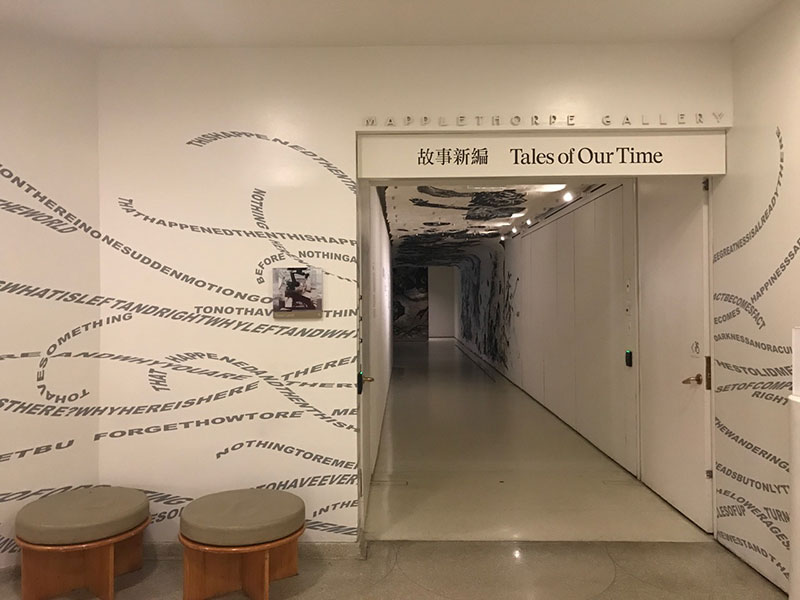
Accueil > Voir, Lire & écrire > Lire & écrire > Tales of Our Time
Tales of Our Time
The Solomon R. Guggenheim Museum November 4, 2016–March 10, 2017
,
The Solomon R. Guggenheim Museum presents an ambitious group exhibition of contemporary Chinese art curated by Xiaoyu Weng and Hou Hanru.
The curators seem not to present what contemporary Chinese art is, but to lay out what contemporary Chinese art can be : the exhibition is not an answer to “What is contemporary Chinese art ?” but rather to pose the question “Where can contemporary Chinese art go ?” Their premise entails giving commissions to artists to create new works, generating tales of our time by asking : “How can I break the rules of how art history is written ? How an exhibition is made ? How art is presented ?”
Tales of Our Time is also tales of our space, or rather time that has a spatial dimension where tales unfold and re-fold like a complex origami. This multidirectional and multidimensional set narratives shifts without clear distinctions between points of view, and the present continually morphs into the past, which morphs into the another present. Alternate histories dance with the present and then switch partners. What shapes this spatiotemporal complex are invisible and untold social pressures, political upheavals, and ideologies. However, the artists generate new combinations to reshape these invisible matters through the acts of writing, talking, translating, and storytelling in dream-like clouds of narrative. The stories form various knots and nodes among them, orchestrating a dynamic fabric of meshwork. This mesh of links allows the sphere of contemporary Chinese art and its historical traces to become more receptive to the influx of new interpretative streams.
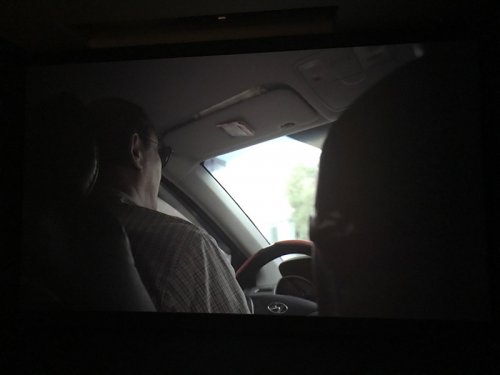
- Chia-En Jao, In Taxi, video, 2016
#History #Border #Territory
History is not fixed, but wide open. This is because our history belongs to the present’s constant reconstitution and reinterpretation. Chia-En Jao engages with Taiwanese history from a multitude of diverse perspectives to alter and expand the discourse of its history and reconsider the hegemonic historical narratives. In Taxi (2016), the artist conducts a series of interviews with Taipei taxi drivers inside their cabs. The artist asks cab drivers to go to places where important historical events have occurred. Drivers deliver stories around the Presidential Palace, the Grand Hotel, Chang Haw Bank, among others. One of the drivers tells of his memories about the border issues in Taiwan by comparing them to recent Brexit. National borders are not just geographic boundaries, but lines to which coherent systems of ideas adhere. Within the bounds of national territory, these systems of ideas set patterned clusters of social beliefs in play. The social beliefs are virtual authorities that affect how we see, think, anticipate and judge. Through the opinion of the cab driver, the audience can see what kinds of logical operations in his mind recognize the territorial issues. The artist attempts a new vision of the history of the city as a node of connections among seemingly disparate experiences and memories, retroactively creating more open conditions by incorporating other thoughts.
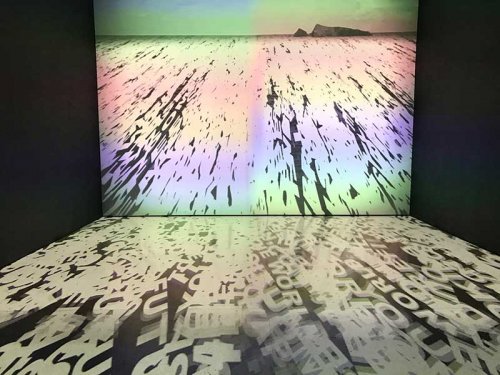
- Tsang Kin-Wah, In The End Is The Word, video installation, 2016
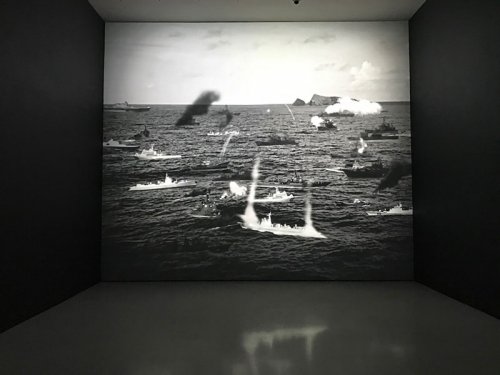
- Tsang Kin-Wah, In The End Is The Word, video installation, 2016

- Tsang Kin-Wah, No(thing/fact) Outside, installation view, 2016
In In The End Is The Word (2016), Tsang Kin-Wah deals with the territorial dispute between China and Japan over the Diaoyu Islands (or Senkaku Islands). These are located to the east of Mainland China, northeast of Taiwan, west of Okinawa Island and north of the Ryukyu Islands. Each country asserts ownership of the islands from a different historical justification. China lays claims to the islands from events in the 14th century, while Japan insists it controlled the islands from the first Sino-Japanese War in 1895. The artist made a multi-channel video animation that features a fictional situation in which various military ships seem to fight against each other, claiming for the borders that define the islands. In the end of the video, a large number of texts come out of the scene to the walls and floor, creating an abstract world of words. They are unreadable because the sentences pass by so feverishly, suggesting the heated on-going political dispute. Tsang also creates text-based installations on the walls inside the Guggenheim Museum. The texts seem to flow around the space without borders because they are installed in multi-directional ways without a beginning or an ending.
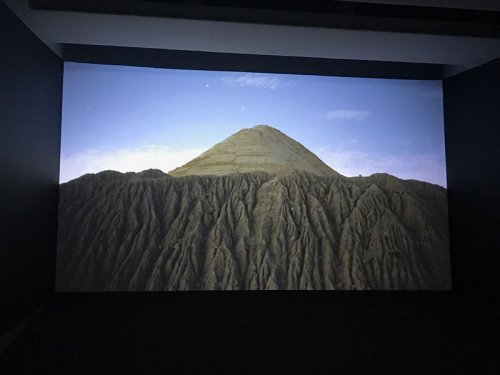
- Zhou Tao, Land of the Throat, video installation(detail), 2016
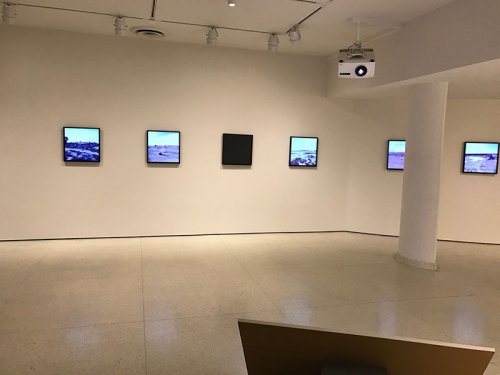
- Kan Xuan, Kū Lüè Er, video installation view, 2016

- Sun Xun, Mythological Time, video installation view, 2016
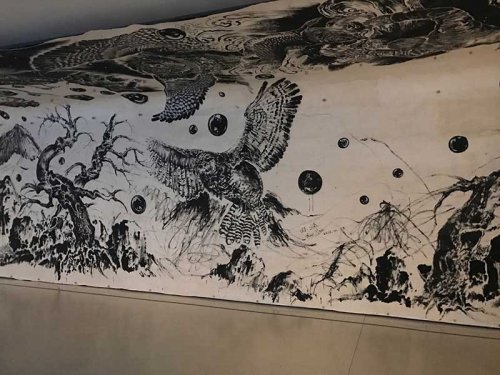
- Sun Xun, Mythological Time, installation view, 2016
#Landscape #Digging #Soil
A landscape consists of the visual features of a natural and/or man-made land. In the era of the Anthropocene, most lands in the world contain the various ancient and modern civilizations. The lands on earth are no longer able to separate the natural and the cultural. In Land of the Throat (2016), Zhou Tao presents a two-channel video exploring a landscape that appears to be a natural hill at first. However, it is an artificial accumulation of waste and soil from so-called “foundational constructions.” For Kū Lüè Er (2016), Kan Xuan traveled across China for five months, taking pictures of the remains of 110 ancient cities with her I-phone. The artist displays the thousands of images she shot during her journey compiled as a series of videos on eleven monitors. The artist searches for Chinese historical dynasties and changing territories that are hidden under the soil of the landscapes. Sun Xun’s Mythological Time (2016), an animated video with sound, and a large ink, graphite and acrylic wall painting, creates a dream-like scene, combining moving images of mythical creatures, flies, tanks, coal miners, and mountains. The video connects the China’s traditional myths in nature with the modern history of coal-mining.
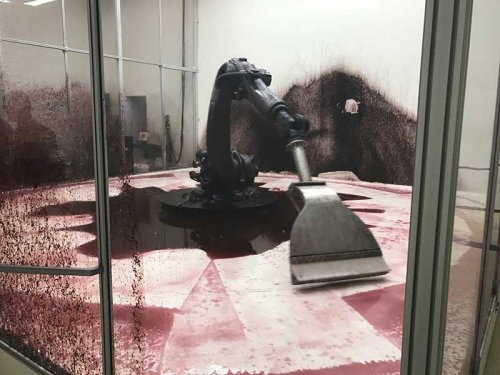
- Sun Yuan & Peng Yu, Can’t Help Myself, installation view, 2016
#Sensual #Dreamy
Some of the artists here offer sensual and dreamy experiences rather than words. In these works the audience senses and feels, rather than reads, stories through bodily experiences. Sun Yuan & Peng Yu presents Can’t Help Myself (2016), a gigantic robot that mops up blood-like liquid based on a set of rules : i.e., a sensor detects the moment when the red liquid flow passes a certain boundary, and the robot then moves its shovel-like arm to clean it up and splash it off to the glass walls. It is a purely visceral experience, but a strong metaphor for what contemporary society is going through. The Yangjiang Group gives a station for people to drink a cup of tea, with a blood pressure station for visitors to measure the calming effect–blood and skin tell the unwritten tales of the audience’s relationship with this historically fraught drink.
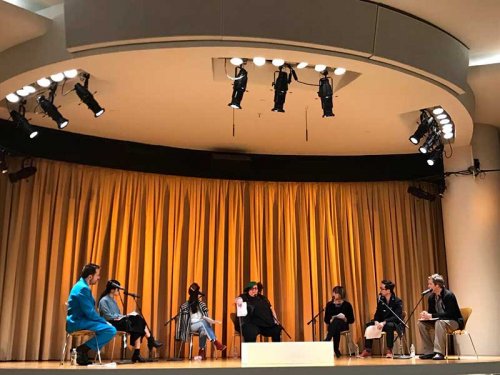
- Marcos Lutyens and Raimundas Malašauskas, Hypnotic Show, 2016
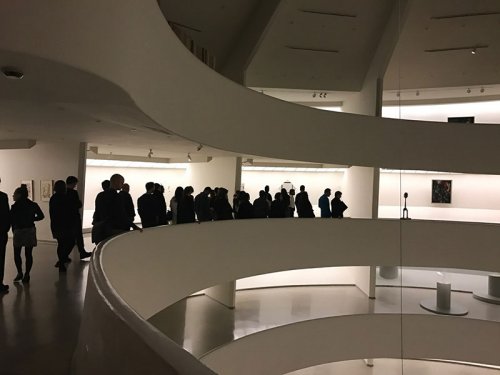
- Marcos Lutyens and Raimundas Malašauskas, Hypnotic Show, 2016
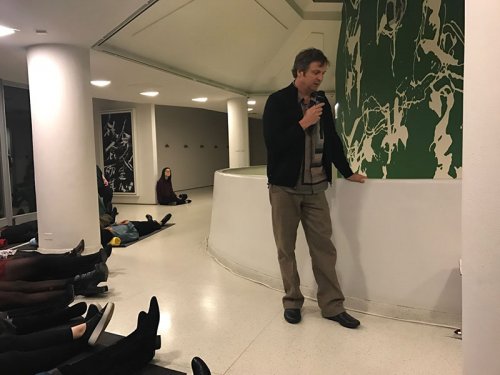
- Marcos Lutyens and Raimundas Malašauskas, Hypnotic Show, 2016
The museum also presents The Hypnotic Show, a project by Marcos Lutyens and Raimundas Malašauskas as one of the public programs related to the exhibition. The Hypnotic Show at first invites people to sit in an auditorium listening to a casual conversation. Then the participants are guided down the Guggenheim’s rotunda and finally lie down on a floor. Lutyens starts to lead them into a trance-like state. With eyes closed, the commissioned texts by seven fiction writers are delivered to listening ears. Lutyens’ soft voice escorts the audiences into sensual realms of fantasy. While there are no external stimuli except the hypnotic voice reading the texts, each person in the audience vividly experiences sense perceptions like colors, textures, smells, and shapes inside the mind. The audience experiences The Hypnotic Show, as with the other artworks in Tales of Our Time, through feelings so orchestrated as to induce an awareness of their very qualities in the actual moment.
